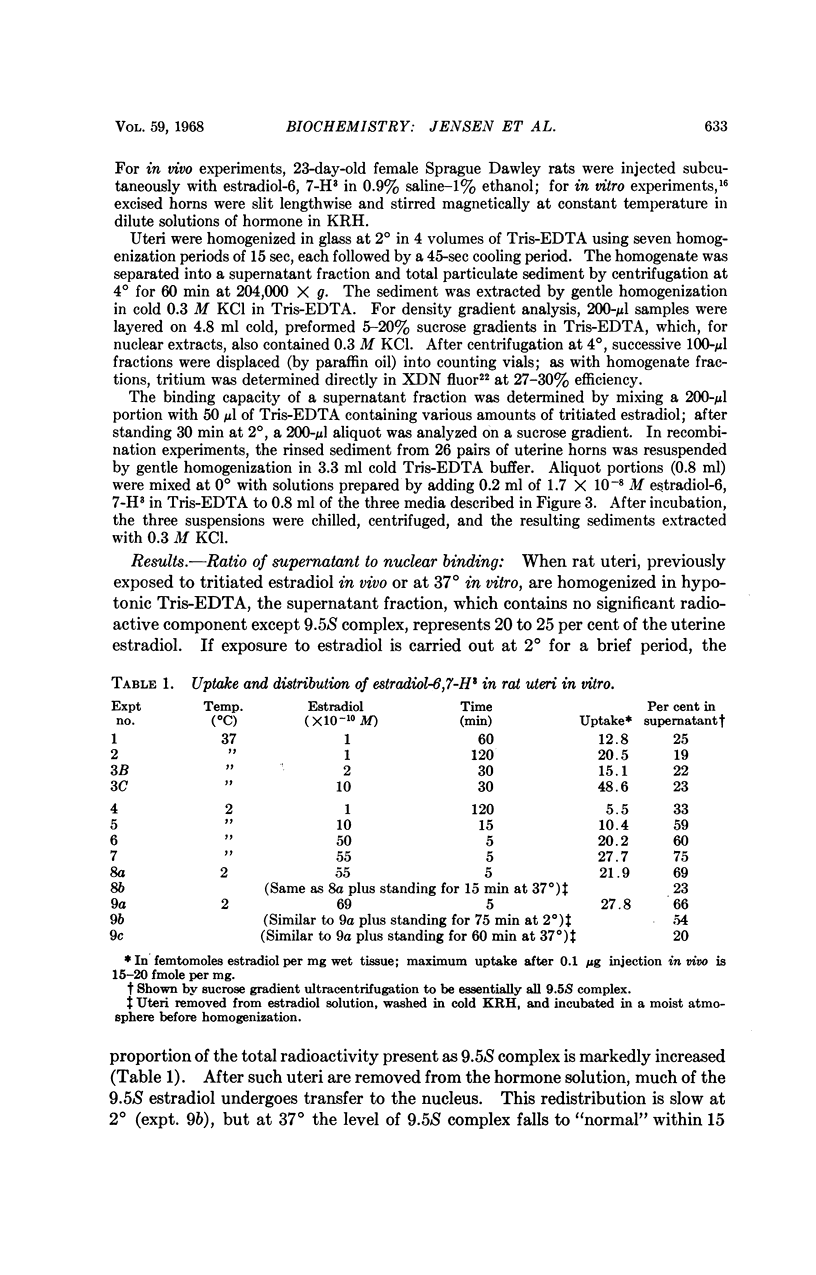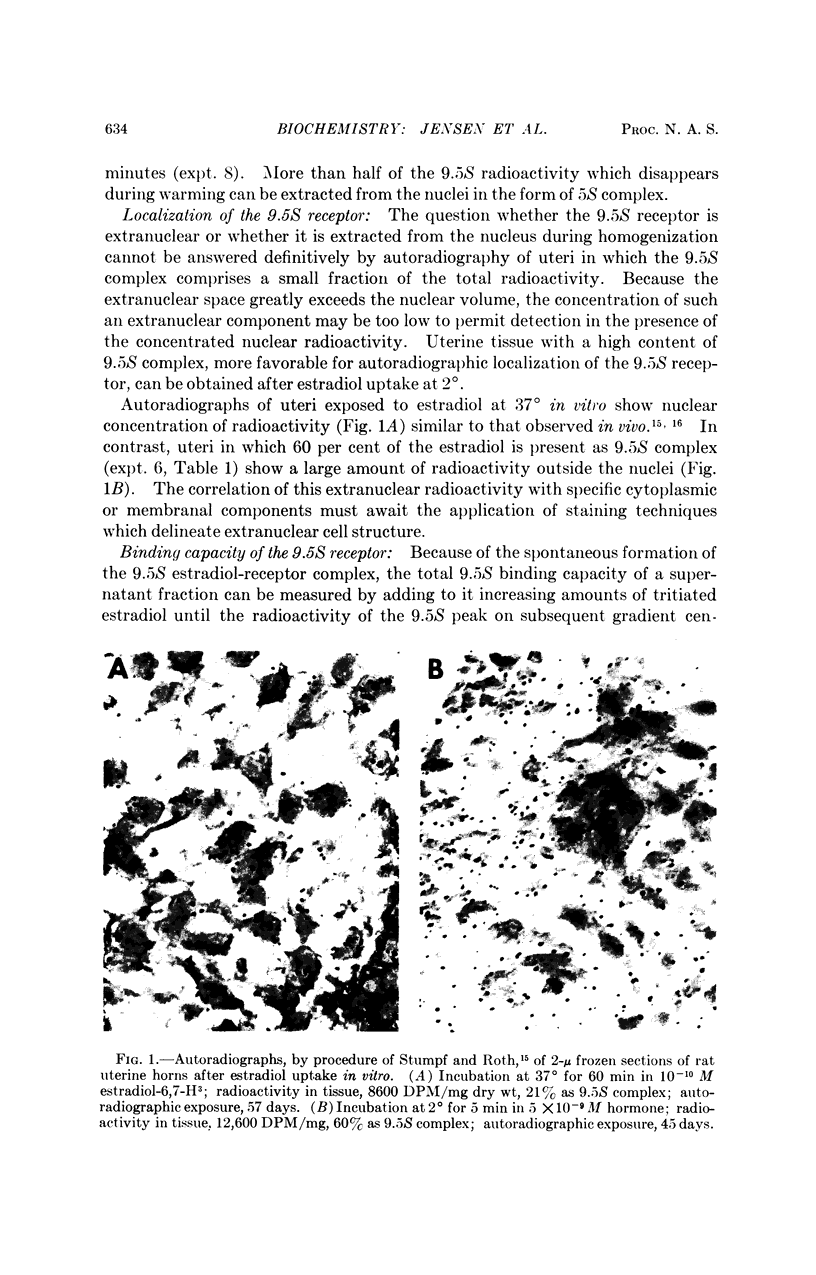Full text
PDF






Images in this article
Selected References
These references are in PubMed. This may not be the complete list of references from this article.
- GLASCOCK R. F., HOEKSTRA W. G. Selective accumulation of tritium-labelled hexoestrol by the reproductive organs of immature female goats and sheep. Biochem J. 1959 Aug;72:673–682. doi: 10.1042/bj0720673. [DOI] [PMC free article] [PubMed] [Google Scholar]
- Jensen E. V., Hurst D. J., DeSombre E. R., Jungblut P. W. Sulfhydryl groups and estradiol-receptor interaction. Science. 1967 Oct 20;158(3799):385–387. doi: 10.1126/science.158.3799.385. [DOI] [PubMed] [Google Scholar]
- King J. B., Gordon J. The localization of [6,7-3H]oestradiol-17-beta in rat uterus. J Endocrinol. 1966 Apr;34(4):431–437. doi: 10.1677/joe.0.0340431. [DOI] [PubMed] [Google Scholar]
- Maurer H. R., Chalkley G. R. Some properties of a nuclear binding site of estradiol. J Mol Biol. 1967 Aug 14;27(3):431–441. doi: 10.1016/0022-2836(67)90049-6. [DOI] [PubMed] [Google Scholar]
- Noteboom W. D., Gorski J. Stereospecific binding of estrogens in the rat uterus. Arch Biochem Biophys. 1965 Sep;111(3):559–568. doi: 10.1016/0003-9861(65)90235-3. [DOI] [PubMed] [Google Scholar]
- STONE G. M., BAGGETT B., DONNELLY R. B. THE UPTAKE OF TRITIATED OESTROGENS BY VARIOUS ORGANS OF THE OVARIECTOMIZED MOUSE FOLLOWING INTRAVENOUS ADMINISTRATION. J Endocrinol. 1963 Nov;27:271–280. doi: 10.1677/joe.0.0270271. [DOI] [PubMed] [Google Scholar]
- STONE G. M., BAGGETT B. THE IN VITRO UPTAKE OF TRITIATED ESTRADIOL AND ESTRONE BY THE UTERUS AND VAGINA OF THE OVARIECTOMIZED MOUSE. Steroids. 1965 Jun;41:809–826. doi: 10.1016/0039-128x(65)90173-x. [DOI] [PubMed] [Google Scholar]
- Stumpf W. E., Roth L. J. High resolution autoradiography with dry mounted, freeze-dried frozen sections. Comparative study of six methods using two diffusible compounds 3H-estradiol and 3H-mesobilirubinogen. J Histochem Cytochem. 1966 Mar;14(3):274–287. doi: 10.1177/14.3.274. [DOI] [PubMed] [Google Scholar]
- TALWAR G. P., SEGAL S. J., EVANS A., DAVIDSON O. W. THE BINDING OF ESTRADIOL IN THE UTERUS: A MECHANISM FOR DEPRESSION OF RNA SYNTHESIS. Proc Natl Acad Sci U S A. 1964 Oct;52:1059–1066. doi: 10.1073/pnas.52.4.1059. [DOI] [PMC free article] [PubMed] [Google Scholar]
- Terenius L. Specific uptake of oestrogens by the mouse uterus in vitro. Acta Endocrinol (Copenh) 1966 Dec;53(4):611–618. doi: 10.1530/acta.0.0530611. [DOI] [PubMed] [Google Scholar]
- Toft D., Gorski J. A receptor molecule for estrogens: isolation from the rat uterus and preliminary characterization. Proc Natl Acad Sci U S A. 1966 Jun;55(6):1574–1581. doi: 10.1073/pnas.55.6.1574. [DOI] [PMC free article] [PubMed] [Google Scholar]
- Toft D., Shyamala G., Gorski J. A receptor molecule for estrogens: studies using a cell-free system. Proc Natl Acad Sci U S A. 1967 Jun;57(6):1740–1743. doi: 10.1073/pnas.57.6.1740. [DOI] [PMC free article] [PubMed] [Google Scholar]




